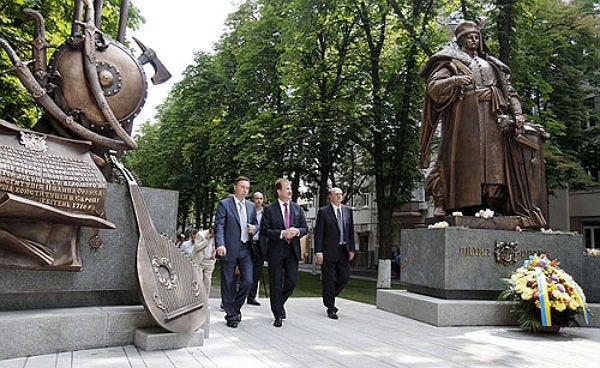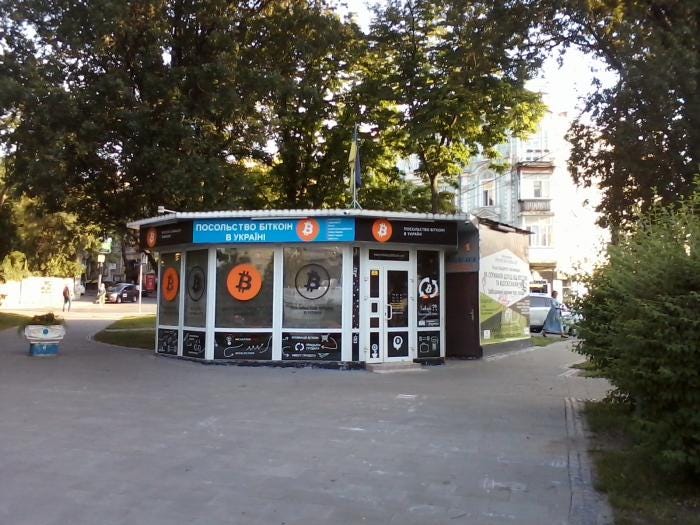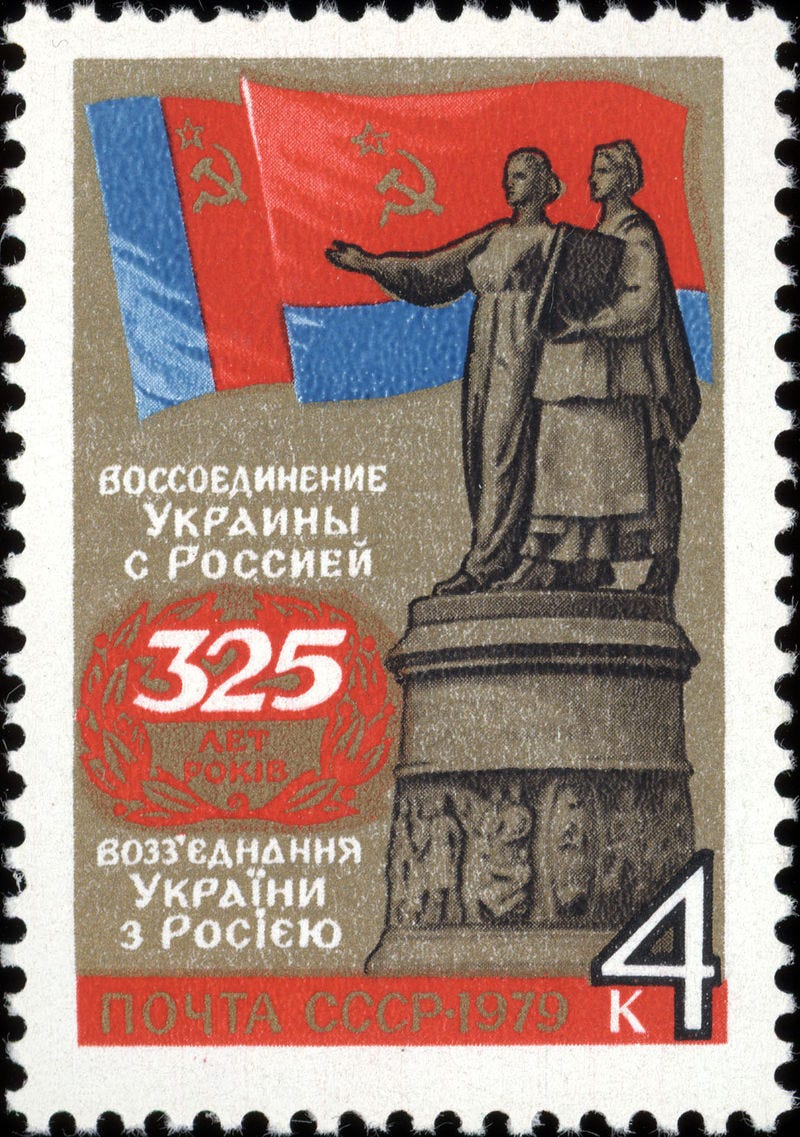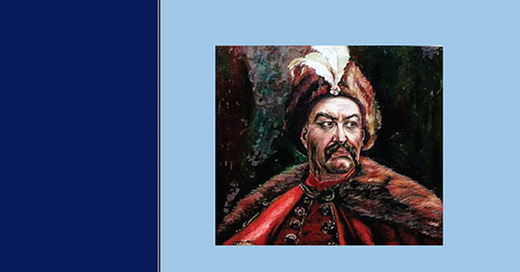17th century Cossack parapolitics
A review of D.A. Bezyev's 2012 book "Ukraine and the Polish-Lithuanian Commonwealth in the first half of the 17th Century". Bitcoin embassy, Polish Sarmatian poetry about smelly peasants shitting...
There is nothing more Ukrainian than a Cossack. If you spend any time in Ukraine you’ll hear that quickly. I remember back in 2016 or so while visiting my family in Kiev, being confused and impressed by the statues of a certain ‘Pylyp Orlyk’. According to Ukrainian media, this Cossack leader ‘created the world’s first democratic constitution’.

There was also the ‘bitcoin embassy’ in the centre of Kiev. Located in a pleasant old soviet café that resembled a flying saucer, it hardly lived up to its techno-promethean promises – the free wifi it promised didn’t work. Nowadays, what with recent news that the much-hyped mobilization app was too faulty to download, despite the fact that Ukraine’s IT-workers enjoy freedom from mobilization due to their ‘strategic importance’, it is hard not to remember the bitcoin embassy.

I never understood what actually happened inside the bitcoin embassy, and sometime around 2019 it became converted to a café, and then to a restaurant (small businesses have a quick lifespan in Ukraine).
But what it did have was a lovely mural on the outside, depicting how Neanderthals first handed first to ax-wielding stone age humans, who then gave it to Ukrainian Cossacks, who finally handed it to Ukrainian IT-professionals. Many IT professionals, often employed by western firms, were at the vanguard of Euromaidan. In a conversation I once overhead with a C14 leader, he proudly mentioned how ‘many of us are coders and IT professionals seeking personal realization’. While lacking industrial policy – or rather, pursuing explicitly anti-industrial policy – Poroshenko’s government made much of how IT would be the driving motor of Ukraine’s economy.

Who were the Cossacks? Most simply, they were an armed group of men living in modern-day Ukraine that were paid by the Polish-Lithuanian Commonwealth to guard its borders.
But as the white-guardist Russian historian Nikolai Ulyanov wrote, there is no national history harder to write than Ukraine’s. He didn’t mean that so much as an insult (though he was hardly positively disposed towards Ukrainian statehood), but because of the vast amount of contradictory narratives surrounding Ukraine, and most particularly the Cossacks.
Here are just some of the ways they could be described:
- Defenders of Europe. In their own words, they were defenders of the Christian faith against Turk, Mongol and other Asiatic invaders at the frontier of Europe
- Defenders of Orthodoxy. Also in their own words, they were defenders of the specifically Orthodox faith against Polish forced Catholicization of what then called themselves the ‘Rusian’ (with one ‘s’) people of contemporary Ukraine, then under the yoke of the Polish-Lithuanian commonwealth (until 1654, when the Cossack leadership of left-bank Ukraine swore an oath to the Muscovite/Russian tsar Alexei Mikhailovich)
- Defenders of Democracy and Ukraine. In the words of some Cossacks, and particularly later Ukrainian nationalist historians, the Cossacks defended the eternal Ukrainian urge towards individual freedom and democracy against Russian authoritarianism. They had their reasons to fight against the Poles, but any alliances with Russia were purely tactical and the terms of the 1654 agreement were soon distorted by Tsarist trickery.
- Pirates, rapists, plunderers. In the eyes of much of the Russian elite until 1654 (but also for many after), the Cossacks were pirates who plundered all their neighbors at will, with whatever allies at hand, no matter how distasteful (for instance, the Tartars). The great Russian historians, from Klyuchevsky to Platonov to Karamzin, all viewed the Ukrainian Cossacks as the most barbarian of all those forces that occupied and plundered Russia in the time of troubles (the first decade of the 17th century, when the Poles briefly occupied Moscow). As Ulyanov put it, the Tartars at least didn’t pillage Muslim cities.
The Marxist historian Egor Yakovlev makes an interesting comparison between Algeria’s pre-colonial pirate elite and their complicated relationship to their ‘brothers in faith in Istanbul’. Bogdan Khmelnytsky’s uprising subjectede Poles to the same depradataions the Cossacks had previously subjected the Russians at the behest of the Poles. As a result, the ‘savage pirate’ assessment also became popular in Poland.
- Traitors whose only scruple was personal gain. Unreliable elements for whom oaths meant nothing. A common opinion among both Russian and Polish authors, for obvious reasons.
- Murderers. The dominant opinion in Jewish literature and memory.
This won’t be the last article on the topic of the Cossacks. Ulyanov, whose book will be the topic of a future post, argues that the ‘roots of Ukrainian separatism’ (the title of his cult classic 1958 book, published while an exiled Yale professor) are to be sought precisely in the nefarious nature of the Cossack elite, and not only in foreign intrigues, which is the preferred explanation for most Russian nationalist authors.
In this post I will be discussing some of the most interesting parts of Russian historian D.A. Bezyev’s 2012 book ‘the position of Ukrainians in the Polish-Lithuanian Commonwealth’.
Bezyev is far from Ulyanov’s polemical white guardism, and generally tries to remain as fair as possible to Ukrainian statehood and Ukrainian nationalist interpretations.
His book begins and ends by noting that the topic of Ukrainian-Polish-Russian relations remains relevant to this day, as does the topic of the origins of Ukrainian nationhood and the meaning of the Cossacks, as well as whether a ‘Cossack Ukrainian state’ existed. He makes several hints to the fact that the tangled relation between ostensibly ‘pro-Russian’ Ukrainian elites and Russia itself remains current. At least on this matter of contemporary political relevance, he is in a sort of agreement with the likes of Ulyanov.
Historiography
The first section of the book concerns existing historiography on the matter, from Ukrainian nationalist, to Soviet, to Tsarist/white-guardist, to Polish. While Bezyev doesn’t dwell on it, one of the interesting things about the Ukrainian Cossack theme is that it has received barely any attention in English language historiography.
What I found most interesting here was his treatment of Soviet historiography. 1954 was the 300-year anniversary of the ‘rejoining of Ukraine to Russia’ – the year when Cossack leader Bogdan Khmelnytsky swore an oath of fealty to the Moscow tsar in the Ukrainian town of Pereiaslav. Consequently, this year saw a wealth of Soviet investigation into the matter.

It had previously been somewhat of a controversial topic, since in the 1920s the Soviet Union supported various Ukrainian nationalist interpretations of history. Mykhailo Hrushevsky, premier Ukrainian nationalist historian and Cossack enthusiast who was head of the Rada in the short-lived Ukrainian People’s Republic, returned in 1924 to continue being a major academic in Soviet Ukraine. Back then, it was difficult to treat 1654, which by Ukrainian nationalist standards is generally considered either a betrayal or an agreement which was distorted by the Russians.
By 1954, the Soviet historiographical assessment of 1654 was generally positive. I found the reasoning quite interesting – while not describing the Cossacks as such as a progressive class, it argued that the Russian empire offered more historically progressive conditions for economic development than the Polish-Lithuanian commonwealth.
Soviet historians pointed to the support for union with Russia among the emerging Ukrainian merchant class. The latter was harshly suppressed in the noble-dominated Polish-Lithuanian commonwealth. In 1566, the Polish nobility restricted merchants from leaving the country. This meant that trade became monopolized by the nobility. The last several centuries of the Polish-Lithuanian Commonwealth (PLC) saw the constant shrinking of its doomed urban centre, with the country’s sole economic purpose to supply cheap food for the growing working class of western Europe, particularly England (opening access to cheap Polish grain was one of David Ricardo’s greatest preoccupations in his arguments in favor of free trade). Western Europe’s working class and capitalist system developed at the expense of Poland’s.
I can recommend a good source on the matter. The first volume of Norman Davies history of Poland - God’s Playground - is forced to describe in detail the self-destructive nature of the Polish ruling elite, despite the polonophile tendencies of the anglo-saxon author.
In short, the Russian empire was able to provide better conditions for the development of capitalism than the PLC. The PLC was relatively unique among European states of the time in the absolute dominance of the nobility over all other classes, including the monarch. Norman Davies in his first volume of God’s Playground compares it to Spain, but even this similarly-backwards country had a far smaller nobility. In most European countries, the nobility accounted for only 1-2% of the population. In Poland, an enormous 10% of the population counted themselves as part of the szlachta nobility. At times, the figure was even higher.
What that meant in practice was that the PLC was possibly the worst place on earth for peasants and merchants. It was one of the few European states where nobles had the right to execute their serfs without permission from King. In Russia, in contrast, kingly sanction was required.
Amusingly, Russian ‘liberal reformers’ of the 17th and 18th centuries would often illustrate their criticisms of ‘Tsarist autocracy’ by reference to their lack of rights to execute and torture their serfs, which they contrasted to ‘free Poland’. The great Marxist historian Mikhail Pokrovsky narrates these debates in volume 2 of his ‘Russian History from the most Ancient Times’.
One of the most fascinating aspects of the PLC was the ideology of the szlachta - Sarmatism. Bezyev’s book goes into this ideology in detail. In short, Sarmatism was the idea that the Polish nobility were not only a separate class from the peasantry - they were a separate race. In the PLC, the peasantry were called chern’ - blacks. According to the Sarmatist ideal, which was endlessly elaborated upon by noble intellectuals, the Polish szlachta were not Slavs, but the remnants of an Iranian tribe - Sarmatians - who conquered the hapless Slavs a millenium ago. Sarmatians could enjoy their 'Golden Liberty’, their ‘Noble’s Democracy’, as they called it. The chern’ should be grateful its Sarmatian overlords let some of them survive. It reminds me a great deal of Confederate odes to liberty, but for whites only.

Here is a wonderful poem Bezyev provides from Mikola Rei (1505-1569), the first classic of Polish noble literature:
‘The peasant who shat under an oak’
A lord was riding along the road and swerved a bit,
There stood a shady oak, and beneath it a serf was shitting,
He got confused, but the lord said: "Don't fuss!
Without this, no one can manage!"
The serf replies: "I, surely, can manage,
I'll leave everything here, sir, and drag myself away.
If you want it – take it, I don't need it.
In exchange, I'll agree to a loaf of bread.
And another, from the same author:
Peasants in the city were buying [an icon] of Christ’s Passion
Some serfs sent two fools to town,
To buy [an icon of] Christ's Passion for the festival,
The master sees they're dolts, and tests them: "Stinky slaves,
How do you want it depicted – alive or post-mortem?"
The peasants discussed: "Better an alive one,
It's always more convenient to acquire such;
If we can't please the villagers - it could even lead to killing,
And if there's a surplus - it can be drunk away."
A note from myself - the terms used to describe the peasants are holop, smerd, and muzhiki. The last one is fairly neutral. The first two aren’t. Holop is a sort of enslaved bondsman. Smerd is most interesting. I have seen it used in sources from ancient Rus, prior to the Tartar invasions (pre-13th century). It means ‘stinky one’, to translate literally. In many respects, I would say that the social structure of the PLC and the Cossacks was a sort of leftover from Ancient Rus, in terms of an extremely hierarchical, backwards society founded on piracy and the slave-trade (many Cossack ‘freedom fighters’ glorified nowadays, like Mazepa and Doroshenko, made their living by selling their compatriots as slaves to the Ottomans and Tartars).
In short, the PLC in the 17th century was a noble-dominated anarchy where cities had been shrinking for over a century, and a serfdom existed harsher than that anywhere else in Europe.
The eastern lands of the PLC suffered from the worst depredations. The largest latifundias were here, owned by the most brutal large magnates. These magnates regularly waged real war against each other using private armies, which devastated the peasantry. The right to armed rebellion against the state was enshrined in the constitution of the PLC, a practice known as ‘confederacja’ (the name of the current far-right Polish political party at the forefront of the blockade of Ukrainian exports). The largely orthodox peasantry was also subject to religious oppression from the Catholic PLC, the country where the counter-reformation was most successful, where extremist Jesuits often played a key role in ‘minority policy’.
Cossack parapolitics
The main event which this book turns around is Bogdan Khmelnytsky’s uprising of 1648.
The Cossack leadership had various demands, the most important of which were they they be given the same rights as Polish nobility. They wished to increase the legal ‘Registry’ of Cossacks given full rights by the Polish crown to more than the existing 6,000-8,000. According to Bezyev and other historians, the Cossack leadership were total Polonophiles, who did not really wish to join Russia, but merely to bargain for better rights as nobles within the PLC. In this, they had common cause with the Polish King, who was tired of total domination by the nobility, which was clearly driving the country to disaster. This is a narrative also reproduced by pro-Cossack Ukrainophile historians such as Kostomarov and Hruschevsky. But like many cunning conspiracies (if it was one), it spun out of control.
Of course, the population of the Orthodox Christian territories occupied by the PLC far outnumbered the Cossacks, with the former at several million. Hundreds of thousands of peasants joined Khmelnytsky in his uprising, in a large-scale armed struggle against servitude. However, the whole problem was that their leaders simply wanted to get the right to own them as their serfs. Nevertheless, many Ukrainian peasants called themselves Cossacks and wore the Tartar uniforms beloved by Tartars, with the naïve hope that by doing so they would never have to be enserfed peasants. But it was due to the support of the masses that Khmelnytsky’s forces, numerically miniscule without popular support, were able to crush the army of the PLC.
At this point, the question arises – why didn’t Khmelnitsky march on Warsaw and Krakow when his forces totally routed the Poles in May 1648 in the battles of Zhovty Vody and Korsun? Historians agree that he could have easily taken the capital at this point. Polish peasants were never particularly sympathetic to the ‘democracy’ of slave-owners. A great example of this is the lack of enthusiasm Polish peasants showed in the 1863 Polish uprising, where they preferred to kill the patriotic nobles that were trying to overthrow Tsarist rule.
But the Ukrainian peasants weren’t being lead by a Thomas Muntzer. They were led by Bogdan Khmelnytsky and co, who simply wanted to enjoy the same privileges as the Polish nobility, the same power of life or death over their helpless serfs. So he agreed upon an awful compromise with the Poles to very slightly increase the size of the registry, which was naturally soon forgotten by the enraged Polish nobility, who were never going to forgive Khmelnytsky - an Orthodox savage, a pirate without noble heritage, the man whose forces massacred thousands of well-born Polish nobles and colonizers… On continued the bloody, never-ending war, until the Cossacks, under pressure from the pro-Russian, anti-Polish masses, were forced against their will to swear fealty to the Moscow Tsar…

There is so much more I want to discuss about Khmelnytsky and the Cossacks. In future posts, I will write about the reluctance of the Moscow Tsar Alexei Mikhailovich to accept the pleadings of the Ukrainian Cossacks to come to their aid against the Poles. Stay tuned. And the next post won’t be free, so I recommend spending some bitcoins or whatever other free Cossack approved currency you have to become a paid subscriber.





I think ‘Tatars’ rather than ‘Tartars’, which is a kind of fishy mayonnaise.
Superb article. Thank you 🙏